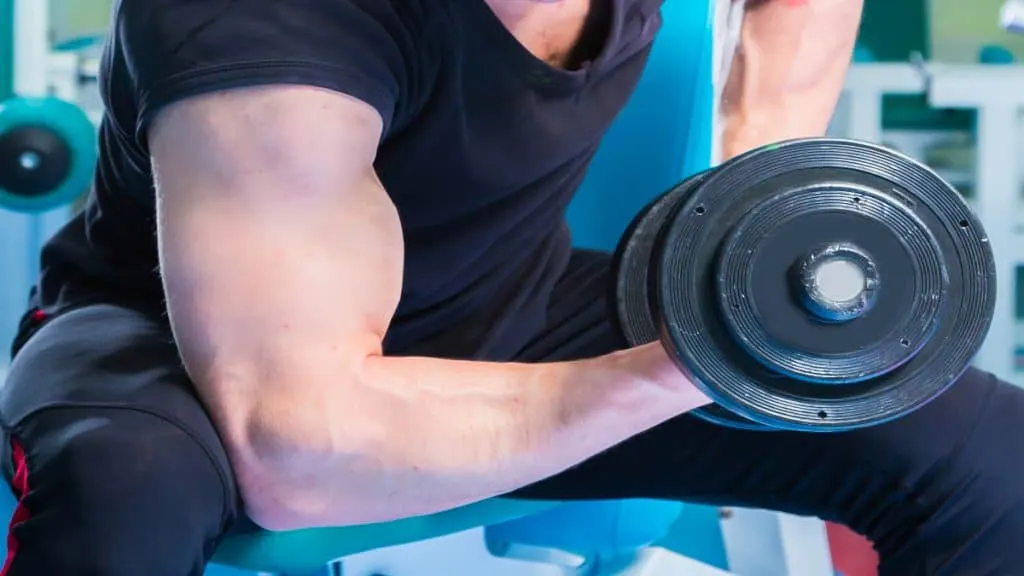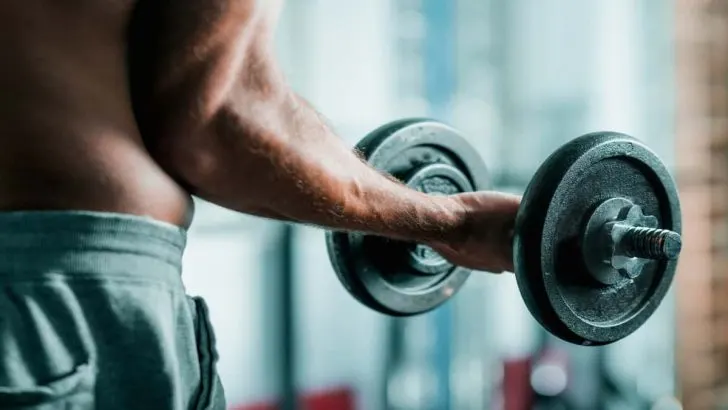Is curling 20 lb dumbbells challenging enough to build your biceps? Also, how much can the average man dumbbell curl?
These are two questions that we hear a lot. So we decided to create case study-focused guides to get to the heart of the matter.
Our main page for the biceps muscles has all kinds of exercise tutorials. However, in this series of articles, we’re investigating whether given resistance levels (e.g., 20 lbs) are enough to build your biceps. So let’s see if 20 lb bicep curls will get you results.
See Our Other Guides:
Is curling 20 lb dumbbells challenging enough to build your biceps?

Whether or not 20 lb dumbbell curls are challenging enough to develop your biceps depends on three things: one, the quality of your lifting technique; two, the number of reps and sets that you perform; three, your proximity to muscular failure.
Regarding the quality of your form, if you’re just swinging the weights around in order to achieve a certain number of reps, then your biceps won’t get much benefit, and, frankly, you’re wasting your time.
If, on the other hand, you’re keeping your elbows and shoulders still and focusing on lifting the dumbbells purely with your biceps, then you’ll likely experience noticeable muscle growth (unless you already have really well-developed biceps).
Of course, the more reps and sets that you perform, the more training volume you’ll naturally accumulate, and so the more potential muscle growth you’ll trigger.
However—and this is the third factor—that training volume needs to be close enough to muscular failure in order to be maximally effective. If you’re stopping 7 reps shy of failure, then, even though you might get a good pump, you’re unlikely to experience any tangible muscle growth.
Conversely, if you’re pushing your biceps close to failure on every set, then you’ll naturally be creating a potent hypertrophic stimulus. [1]
How to make 20 lb dumbbell curls more challenging

The first way to make 20 pound curls challenging—if you’re a novice lifter—is to simply curl normally. And that’s because 20 lbs is already a significant amount of resistance for a pair of biceps that don’t yet have much muscle on them.
Of course, if you can already curl 20 lbs with ease, then you should try some of the following intensity techniques.
Slow negatives make your biceps work harder by increasing their time under tension. [2] So if you can easily do 20 normal reps, then try and lower the weight over a 4-second period to really make your biceps burn.
Similarly, you could perform an extended isometric contraction at the most challenging phase of the rep, which, for a bicep curl, is when your forearm and upper arm create a 90-degree angle at the elbow joint.
Another tactic to make 20 lb curls harder is to perform multiple curl variations in one set. So you’d start with the hardest variation (reverse curls), move on to the next hardest (bicep curls), and then end with the easier curl (hammer curls).
This intensity technique works your brachialis and brachioradialis muscles as well as your biceps.
20 pound bicep curl case studies
Learn how different people made curling 20 pounds more challenging for their biceps.
Case study 1: FitnessNick
The man behind the YouTube channel FitnessNick created a great video showing how to make your 20 lb bicep curls go further.
Essentially, you start off by performing 10 reps with your right arm followed by 10 reps with your left arm (you can, of course, train your left arm first).
Anyway, you keep working your right and left biceps in an alternating fashion. But in order to manage the inevitable bicep fatigue and prolong your set, you’re going to decrease the reps by one on every set.
So it’s 10 reps per arm on the first set, 9 reps per arm on the second set, and so on.
The aim is to pyramid all the way down until you only get 1 rep per arm. From there—by which I mean during the next session—you can either increase the resistance or start and finish with a higher number of reps (e.g., start at 20 and finish 10).
Case study 2: Chris Wilson
Fancy getting the best bicep pump of your life without any weird or confusing intensity techniques?
Okay, the idea is to do a 20 lb bicep curl for as many reps as possible.
This is a lot harder than it sounds.
If you can get over 50 reps, that’s great.
If you can do more than 100, then you’re a beast.
I recommend starting with bicep curls and then switching to hammer curls once your biceps feel like they need more assistance from your brachialis and brachioradialis.
Case study 3: Gabriel Dunkin
So many people want to get results and yet aren’t willing to put in consistent work.
Well, according to Gabriel Dunkin, consistency—more so than lifting heavy weights—is the number one way to build your biceps.
Gabriel did 20 lb bicep curls every other day, and he only did 3 sets of 12 reps, which likely wasn’t to failure for him.
Of course, when you’re training so frequently, curling to failure every session would make it hard for your biceps to recover.
So you can either train less frequently but closer to failure 1-2 times per week. Or, you can do 20 pound dumbbells curls every other day like Gabriel.
Choose the strategy that motivates you the most and stick with it. There’s more than one way to get great results from 20 lb curls.
Conclusion: Who can get results from doing 20 lb bicep curls?

If you can only curl 20 lbs and you’re a novice lifter, then you shouldn’t feel bad. As you hopefully learned in this article, consistency and good lifting technique are more important than the amount of weight that you’re lifting.
Of course, there comes the point in everyone’s training career when increasing the resistance can often lead to new muscle growth.
Yet, most people don’t realize just how much size gain they can milk from a given weight.
While curling 20 lb dumbbells might not seem challenging, it can work wonders for a small muscle group like the biceps.
References
- Willardson, J. M. (2007). The Application of Training to Failure in Periodized Multiple-Set Resistance Exercise Programs. The Journal of Strength and Conditioning Research, 21(2), 628. https://doi.org/10.1519/r-20426.1
- Mohr, C., PhD. (2019, May 6). Think ‘Negative’ To Grow! Bodybuilding.Com. https://www.bodybuilding.com/fun/mohr108.htm

